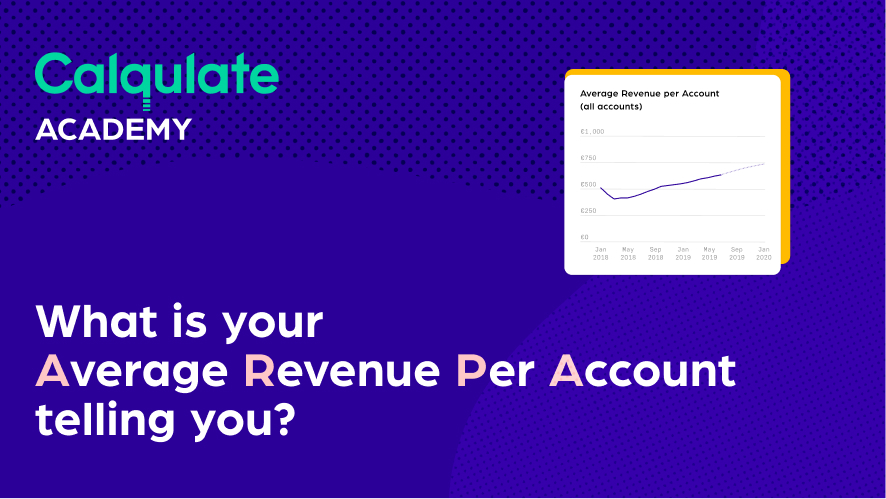What is ARPA?
Average Revenue Per Account (ARPA) is a profitability metric that measures your company’s revenue per customer account. Subscription-based businesses use it to assess their:
- Performance
- Customer Acquisition Costs (CAC) Payback Time
- Revenue forecasting
- Customer segmentation
- Customer Lifetime Value (LTV)
How to calculate ARPA?
You can calculate your ARPA on a monthly or annual basis. The formula to calculate your ARPA is pretty straightforward:
Recurring revenue / Total number of customers for the given period = ARPA
Therefore, to calculate your ARPA monthly, you only need to know your:
- Monthly Recurring Revenue (MRR)
- Total customers for the given month
To calculate your ARPA on an annual basis, you only need to know your:
- Annual Recurring Revenue (ARR)
- Total customers for the given year
For example, if your variables are as such:
Number of customers: 14
Total MRR = $1400
$1400/14 = $100
Your ARPA for that given month is $100.
Your ARPA is data. What is it telling you?
As mentioned, you can use your ARPA to assess your company’s performance, CAC payback time, revenue forecasting, customer segmentation, and customer lifetime value.
Performance
Your ARPA indicates the health of your business financially. It provides insights into your marketing and sales efforts in attracting the right customers—which is directly related to your CAC.
For example, a good customer payback time is less than 12 months. If your CAC is still higher than your ARPA after 12 months, what does it tell you?
The obvious answer is you’re burning too much money and not getting enough payback. But more than that:
-
-
-
- It may be time to revise your pricing strategy.
- Consider switching your monthly deals to annual deals.
- Make adjustments to your marketing and sales expenses.
- Ensure product validation—is it working properly?
-
-
You can also use your ARPA to compare the performance of your company with that of your competitors, and make a growth analysis.
Customer Acquisition Cost Payback Time
Your CAC payback time tells you how long it takes for you to break even from your CAC. The key to increasing your revenue growth is to aim for a CAC payback time of less than 12 months. The more you’re able to push it to under 12 months, the more available cash you have for scaling customer acquisition.
Go deeper: Understanding your Customer Acquisition Costs (CAC) payback time. In this lesson, we’ll show you examples on how to achieve that hockey stick growth effect.
Revenue forecasting
The word ‘Revenue’ in ARPA clearly shows what it does—your ARPA monitors your revenue fluctuation.
Revenue forecasting tends to be the biggest headache for many startups because it takes time to build a solid MRR base. You probably have to test a few pricing strategies to figure the best one before you could get there.
Your ARPA comes in handy when you are planning to apply changes to your pricing strategy. If you made changes to your offers for old and new customers, you will know if that resulted in success or failure. Your ARPA helps you figure out which pricing plan brings the highest revenue, what customers are willing to pay for, and so on.
For example, you have a monthly subscription plan of $200 and your churn rate is 10%. While churn is inevitable, your goal is to reduce your churn rate. Because lower churn means higher revenue.
The assumption is: your customers are leaving because your pricing is too high.
They may have a need for your product but are not ready to pay for that subscription plan yet. To reduce churn, you can:
-
-
-
- Make more features available with the same price. Your customers get more than what they are currently paying for; or
- Unbundle and build a pricing package based on an upselling pathway that starts low (in this case, $100 per month) but allows them to upgrade through add-ons that suit their needs.
-
-
If your ARPA shows improvement after this pricing change, then it means that your previous pricing was too high. If your ARPA still doesn’t improve, it means that you need to improve other areas such as your customer service or the product itself.
Customer segmentation
Customer segmentation is crucial in building deeper relationships with your customers, reflecting in your Customer Lifetime Value (LTV) and Net Revenue Retention (NRR).
Your ARPA is valuable for comparing your customer segments to help determine:
-
-
-
- Which customer segments have the highest LTV and NRR, or the lowest churn
- Which customer segments have the most profitable LTV to CAC ratio and shortest CAC payback time
- Trends in account expansion and downgrades
- Evaluate your pricing strategy
- Types of customers that contribute most to your revenue growth
-
-
The more you understand how your ARPA evolves, the better. Use your customer lifetime value (see next point) to determine your customer segmentation analysis.
Customer lifetime value (LTV)
Your Customer Lifetime Value (LTV) gives you an idea of how much repeat business you can expect from a customer and how much you can spend on acquiring and retaining them.
While it is tempting to try to please EVERY customer, it is also an impossible task. Imagine how many features you need to roll out just for that. That translates into costs...and more costs.
The truth is, it is enough to only focus on a selected group of customers. Here’s why:
Your aim is to build deeper relationships with them and foster a longer-term customer loyalty. It is cheaper to retain existing customers than to keep acquiring new ones. Your LTV helps you determine which customer segment to focus on.
The formula for calculating your LTV is pretty straightforward:
ARPA x Average purchase frequency x Average customer lifetime
= Customer Lifetime Value
Go deeper: What is Customer Lifetime Value?
Key takeaway:
Your ARPA is a health indicator of your company’s profitability. Yes, it’s a growth metric that your investors will be looking for. The best way to grow your ARPA is to have a scalable pricing model that allows you to expand your Net Revenue Retention through upselling and cross-selling quickly. At the end of the day, it still boils down to attracting the right customers and keeping them happy.
Happy Calqulating!

